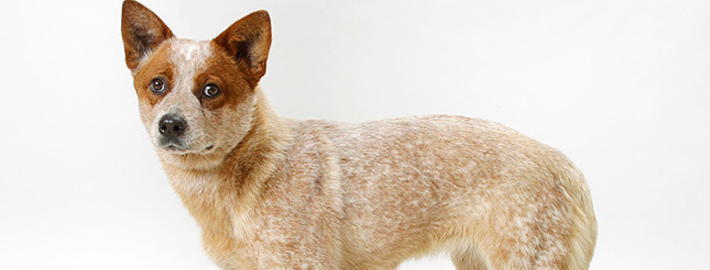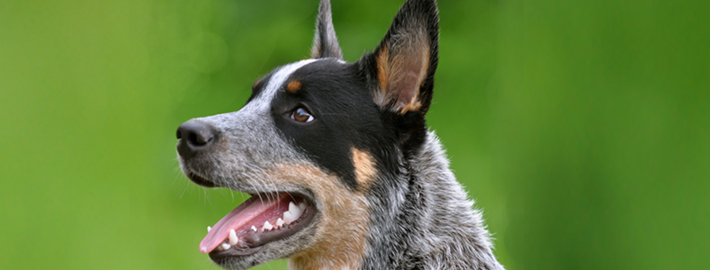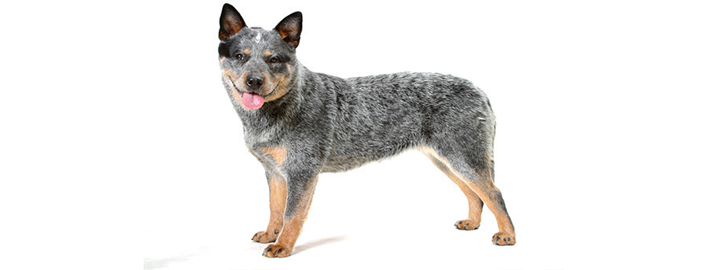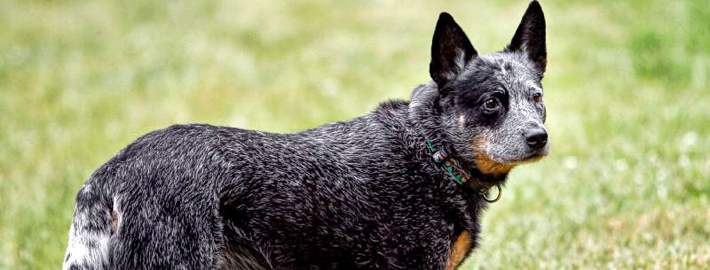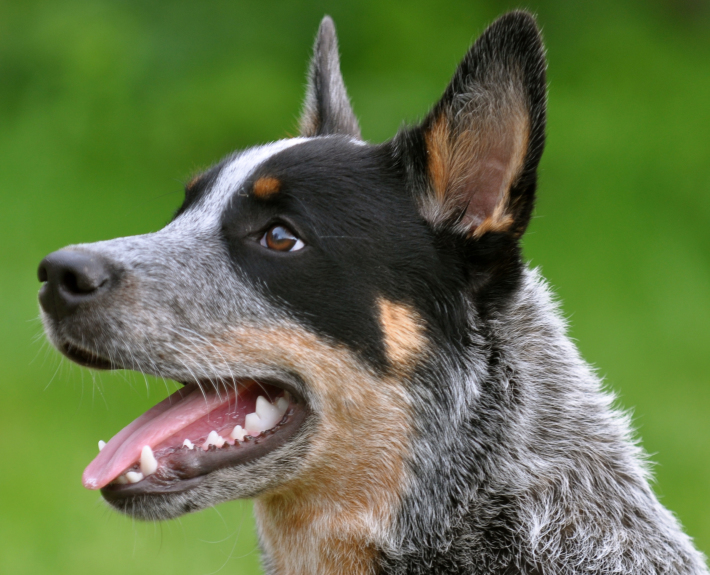What makes the Australian Cattle Dog Unique?
Able to herd even the most reluctant cow, the Australian Cattle Dog is an excellent breed of working dog. These dogs perform well even in hot climates and on rough terrain.
Breed Groups
Page Contents
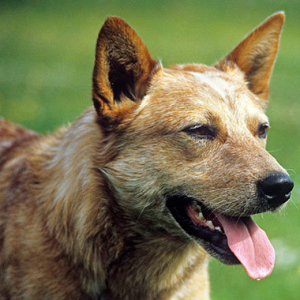
SnapShot
Is the Australian Cattle Dog Right For You?
These dogs are devoted to their human family members and tend to follow them around when possible. Australian Cattle Dogs generally get along well with children as long as the dogs are taught that they should not nip at youngsters in attempt to herd them.
These dogs are intelligent but they can also be very stubborn. Australian Cattle Dogs are known to start testing their limits once they leave puppyhood behind. Therefore, they are probably not a good choice for first time pet owners or individuals who want a dog that is eager to please
In 5 Words
- Protective
- Cautious
- Obedient
- Loyal
- Energetic
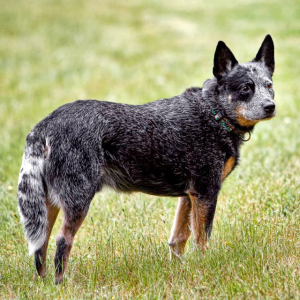
Characteristics
Learn About the Australian Cattle Dog
Description
General Description
Australian Cattle Dogs are medium-sized canines with compact bodies, strong limbs, and an athletic build. These factors enable them to be agile in the course of their duties. Members of this breed are also somewhat longer than they are tall. These dogs additionally possess wide skulls, strong heads, muscular necks, and level backs. Their average sized ears are set far apart and perk up when the dog’s attention is captured by something. Australian Cattle Dogs have black noses and dark brown eyes. Their teeth typically meet in a scissors bite. Low-set, curved tails are yet another feature of this breed.
Size
Australian Cattle Dogs of both genders weigh between 33 and 49 pounds (15 and 22 kilograms). Male dogs stand slightly taller than their female counterparts at 18 to 20 inches tall (46 to 51 centimeters), while the females average between 17 and 19 inches (43 and 48 centimeters) in height.
Coat
Members of this breed possess a glossy double coat that is relatively waterproof. Although puppies are born white due to earlier crossbreeding with Dalmatians, their eventual color can sometimes be determined by looking at the pads of their paws. Adult dogs come in red mottled, red speckled, blue speckled, blue mottled, or plain blue varieties. Some dogs will have markings on their bodies that should be tan, red, or black and tan according to American Kennel Club breed standards.
Short History of the Australian Cattle Dog
During the early portion of the 19th century, the citizens of Sydney began progressing westward across the open plains to new grazing pastures that had recently become available. Ranchers that moved their cattle out to the region found the animals becoming obstinate and unmanageable in their new home. As a result, they started to import skilled herding dogs from elsewhere to combat the problem but these breeds were poorly suited to the local environment. While the imported dogs were effective at using their loud barks to control sheep, this trait only served to startle the half wild cows. It wasn’t too long before the ranchers decided to create a breed of their own. These dogs would be able to withstand the heat, work long hours, and quietly manage the obstinate cattle. Thus, the Australian Cattle Dog came into being. By the early 20th century, a standard had been adopted by breed enthusiasts. Australian Cattle Dogs were eventually recognized by the American Kennel Club in 1980.
Temperament
These dogs are devoted to their human family members and tend to follow them around when possible. Australian Cattle Dogs generally get along well with children as long as the dogs are taught that they should not nip at youngsters in attempt to herd them. Members of this breed tend to be suspicious of strangers but they are not usually hostile towards outsiders. However, Australian Cattle Dogs have been known to defend their territory if they feel the occasion calls for it, so early socialization is recommended to keep problems from arising in later years.
Members of this breed are not suitable for apartment life because they react badly to being cooped up. Anyone that considers adopting an Australian Cattle Dog should be an active individual rather than couch potato, because folks that own one of these dogs will have to keep up with a pet that has a copious need for exercise and mental stimulation. After all, this breed was created to be a working dog and their energy levels reflect that fact.
Caring for Your Australian Cattle Dog
General Health
Australian Cattle Dogs do not have a lot of health problems but they are prone to genetic defects that can sometimes cause deafness, blindness, or paralysis. Reproductive issues, joint problems, and musculoskeletal ailments have likewise been reported in members of this breed on occasion. However, Australian Cattle Dogs seem more likely to wind up at the vet’s over minor injuries that occur they are working such as torn ligaments and fractures.
Care
Daily
Australian Cattle dogs need lots of exercise on a daily basis, much more than a simple 15 minute stroll around the block. Adult members of this breed will enjoy activities such as jogging, accompanying bicyclists, playing fetch, and going on long walks if they are not to be working animals.
Weekly
To prevent tooth decay and foul breath, pet owners will want to brush their dog’s teeth on a regular basis.
Monthly
Parasite prevention medication should be given to dogs to keep them healthy. Most of these products will need to be administered once per month in order to obtain adequate results.
Grooming & Bathing
Australian Cattle Dogs are an extremely low maintenance breed. Individuals that live outside don’t have to be groomed at all, but dogs that sleep indoors may benefit from being brushed a few times per week to keep the loose hairs down to a minimum. These dogs only need to be bathed once a year unless they get especially dirty. As with most breeds, owners will need to keep their dog’s toenails trimmed to prevent injuries from occurring.
Australian Cattle Dogs are an extremely low maintenance breed. Individuals that live outside don’t have to be groomed at all, but dogs that sleep indoors may benefit from being brushed a few times per week to keep the loose hairs down to a minimum. These dogs only need to be bathed once a year unless they get especially dirty. As with most breeds, owners will need to keep their dog’s toenails trimmed to prevent injuries from occurring.
Exercise & Training
These dogs are intelligent but they can also be very stubborn. Australian Cattle Dogs are known to start testing their limits once they leave puppyhood behind. Therefore, they are probably not a good choice for first time pet owners or individuals who want a dog that is eager to please. Australian Cattle Dogs need a firm hand and consistent rules in order to function at their highest levels. They also require an outlet for their abundant energy as well as plenty of mental exercise. Otherwise, seriously undesirable behaviors such as destructive chewing, excessive barking, and copious digging will be the result. It is perfectly fine to let members of this breed live in the backyard, but they nonetheless benefit from regular interaction and grow quite attached to their human family members. As a result, members of this breed should probably sleep indoors with their owners unless they are needed to keep an eye on the livestock during the night.

